According to the Department: Agriculture, Forestry and Fisheries (DAFF) there are only 250 goat stud breeders in South Africa. Goats are found in all provinces of South Africa with Eastern Cape, Limpopo and KwaZulu-Natal producing about 70% of all goats in South Africa.
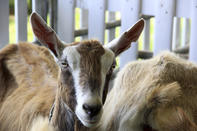
The Boer goat, Savanna and Kalahari Red are currently considered the three most important commercial goat breeds for goat meat production in South Africa. Goat meat is often called chevon when from adults and cabrito when from young animals. Angora goats produce mohair and are shaved twice a year.
The majority of mohair producers are in the Eastern Cape and the fleeces are processed and sold in Port Elizabeth. Indigenous goat farmers and breeders were in the past mainly concentrated in the Eastern Cape province but are now found in Limpopo, North West, KwaZulu-Natal as well as in the other provinces of South Africa.
In commercial meat farming, the indigenous veld goat (IVG) is not as high-yielding (due to its small carcass) compared to the meat goat breeds such as the Boer goat.
Indigenous goats are, however, highly sought-after for use in cultural and religious practices and celebrations in South African culture and attain high prices at certain times of the year when these festivities are held. In addition to meat, IVG milk production is ample, certainly adequate to raise twins or multiples. Skins and cashmere can also be produced from IVG’s.
Meat Goat Breeds of South Africa
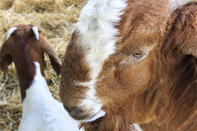
Breeds such as the Boer goat, Savannah and Kalahari Red are world-renowned and most sought after for their superior characteristics such as adaptability, hardiness, good maternal instincts, meat production and high reproduction rate.
The famous meat goat breed ‘Boer’ originated in South Africa. It is a very popular and highly productive meat goat. Chevon is between 50 - 60% lower in fat than beef but has the same protein content. Chevon is also lower in fat than chicken and does not have the ‘gamey’ taste of venison.
The Tankwa Goat
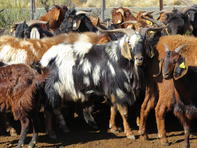
The Tankwa goat, a feral goat found in the Tankwa Karoo National Park is in the process of being registered as a new breed at the Department of Agriculture, Forestry and Fisheries (2018).
A study has shown that this goat is a separate cluster from meat and milk type goats in South Africa and will be established as a landrace breed and not as an 'Indigenous Veld Goat' (IVG).
Indigenous Veld Goat Breeds (IVG) of South Africa
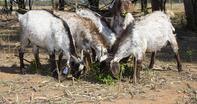
Four ecotypes of goats exist within the IVG classification in South Africa. An ecotype is a genetically distinct race within a species (similar to dogs). The Nguni type (Mbuzi) is the smallest of the four and often displays Swiss markings.
The Eastern Cape Xhosa lob-ear is a large robust animal with large droopy ears. The Northern Cape Speckled is a large goat with a white body with red-brown or black spots. The Kunene-type Kaokoland goat is a medium-size goat with long thin legs and a two-toned colouring.
The IVG society in South Africa is growing rapidly with several new clubs established in various provinces. Information days and auctions are popular and interbreeding between the eco-types are discouraged.
Milch Goat Farming in South Africa
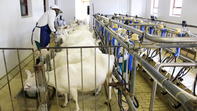
Milch goat farming (milk goats) is growing in popularity. However, given the high occurrence of cow milk allergy, there are considerable opportunities for goat farming business to expand in South Africa.
Yet, the concept of the use of milk goats for small-scale developing farmers in South Africa has not been taken up and pursued by the government, despite specialists running courses for five years. The Department of Agriculture, Forestry and Fisheries considers the Saanen breed as the major milch goat breed in South Africa due to her high yields - over 1 200 litres of milk in a 10-month lactation cycle.
Other milch goat breeds used in South Africa include the Toggenburg (grey or brown with white stripes on the face), British Alpine (black with white markings), French Alpine, Anglo-Nubian and the Bunte Deutsche Edelziege (BDE). Apart from dairy products, goat milk is also used in body and skincare products.
Fibre Goats in South Africa
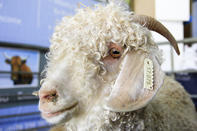
Sheep produce wool, but goats produce fibre - cashmere and mohair. Cashmere - a type of fibre, not a breed of animal - is combed off from the undercoat of goats and is highly prized for being warm, soft and long-wearing.
The Gorno Altai and the Saffer are two goat breeds recognised for their production of cashmere while the Angora goat produces mohair. Angora goats are shaved twice yearly (Angora goats do not moult) whereas cashmere can be collected when goats moult in springtime.
Studies done by the ‘Cashmere Programme’ guided by various groups that formed the ‘Cashmere Working Group’ in South Africa in the 1990’s showed that indigenous goats such as the Boer goat, have two coats - the coarse guard hair, and a fine or cashmere type of fibre. Of over 4 000 fleece samples testes, over 80% were found to contain the cashmere type down.
But the quantity of cashmere fibre was generally not at a level that is commercially acceptable. Average down fibre weight for Boer and Savannah goats was 25 gm per goat and indigenous goats averaged 12 gm per goat. In his report on the study, Albie L. Braun found that down fibre length and yields of cashmere can be improved by breeding indigenous goat ewes with imported high-yielding cashmere rams.
Cashmere production is time and labour intensive and requires about 20 minutes to comb a goat. Still, a small company in the Eastern Cape near Butterworth is producing high-quality cashmere products from the fibre of the Mbuzi indigenous goat.
Mohair is produced by the Angora goat mainly in the Eastern Cape and Karoo, of which more than 50% is exported. The South African Mohair Growers’ Association (SAMGA) supports Angora goat farmers.
By Marinda Louw